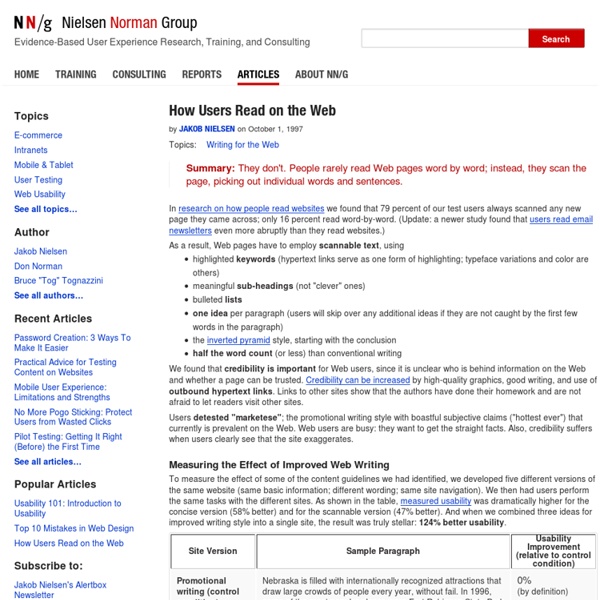



http://www.nngroup.com/articles/how-users-read-on-the-web/
The Font Matcherator - Find a font from any image Font Finder Have an image with type and you don't know what the font is?Upload it and we’ll find the fonts that match. Your Image The Cab Ride I'll Never Forget “Great moments often catch us unawares….” By Kent Nerburn There was a time in my life twenty years ago when I was driving a cab for a living. It was a cowboy’s life, a gambler’s life, a life for someone who wanted no boss, constant movement and the thrill of a dice roll every time a new passenger got into the cab. What I didn’t count on when I took the job was that it was also a ministry. Because I drove the night shift, my cab became a rolling confessional.
Nice Web Type – Pure CSS text gradient (no PNGs) Folks, grab a copy of Safari 4. This is what we’ll be making today: That’s not an image, it’s HTML text with real fonts provided by Typekit and embedded via CSS @font-face. General Fiction Getting Around... Career Essentials Getting Started Queries & Manuscripts Market Research Classes & Conferences Critiquing Crafting Your Work Grammar Guides Research/Interviewing Writing Contests The Writing Business Income & Expenses Selling Reprints Collaboration Pseudonyms Negotiating Contracts Setting Fees/Getting Paid Rights & Copyright Tech Tools The Writing Life The Writing Life Rejection/Writer's Block Health & Safety Time ManagementColumn: Ramblings on the Writing Life Fiction Writing - General General Techniques Characters & Viewpoint Dialogue Setting & DescriptionColumn: Crafting Fabulous Fiction
Benton Modern: Case Study On Responsive Web Typography Advertisement Having the ability to set legible body copy is an absolute must, and we’ve come a long way with web typography since the dawn of web design. However, I feel like we have allowed the lack of variety prior to the rise of web fonts to dampen our creativity now that thousands of web fonts are at our disposal. Have usability conventions and the web’s universality steered us away from proper art direction? Have we forgotten about art direction altogether? I believe so. publish a book? If you've never truly considered writing a book, take another look at the rubbish filling bookshelves at airport kiosks. The "authors" of that stuff are laughing all the way to the bank. While English majors and real literary types are screaming at each other in the stuffy halls of academia or the pages of The New Yorker, these clowns are quietly rehashing tired plots and making millions for it. You're a smart person, so we see no reason you shouldn't take a crack at making bank as well. (Heck, even if you're a ding-bat, we think you should give it a try. Al Gore's books sold millions.)
60+ best free fonts, Summer 2015 2015 continues to be a fantastic year for fonts. Type designers are increasingly prolific and there’s a new design for every possible project, often completely free, or with a free option or weight. There are a couple of dominant trends for Summer: The first trend is a revived interest in ethnic and folk art styles, like the colorful approach of Tripel Six, or the charming Quirko; the second trend is a move away from the geometric sans-serifs that we’ve seen recently, towards more humanist sans-serifs, like Qontra.
Write Your Name in Elvish in Ten Minutes Write Your Name in Elvish in Ten Minutes You want to write your name in Elvish, but every place you go seems to make it harder than it ought to be. Elvish writing looks beautiful and mysterious, but does it really have to be impossible to understand? The Typographic Details Behind Typewolf’s Favorite Sites of June 2015 July 7, 2015 This is the 17th installment of my monthly feature on Typewolf where I share my favorite type-driven websites from the previous month and then write a little about the typographic details behind the designs. You can check out last month’s post for May here.
PAGE QUOTE - Credibility can be increased by high-quality graphics, good writing, and use of outbound hypertext links. by hfernety Nov 22